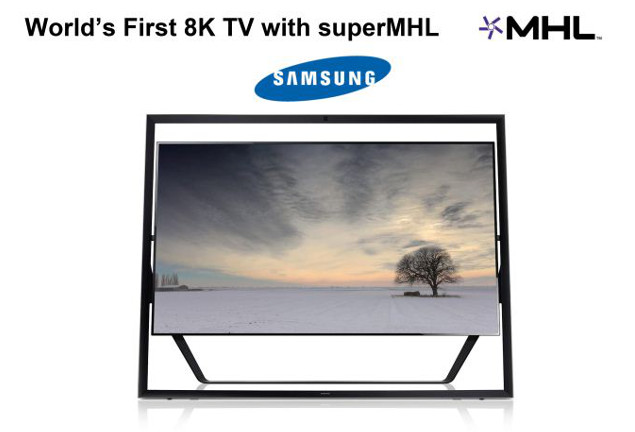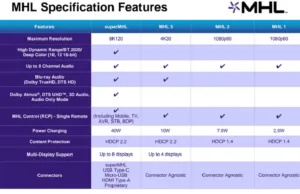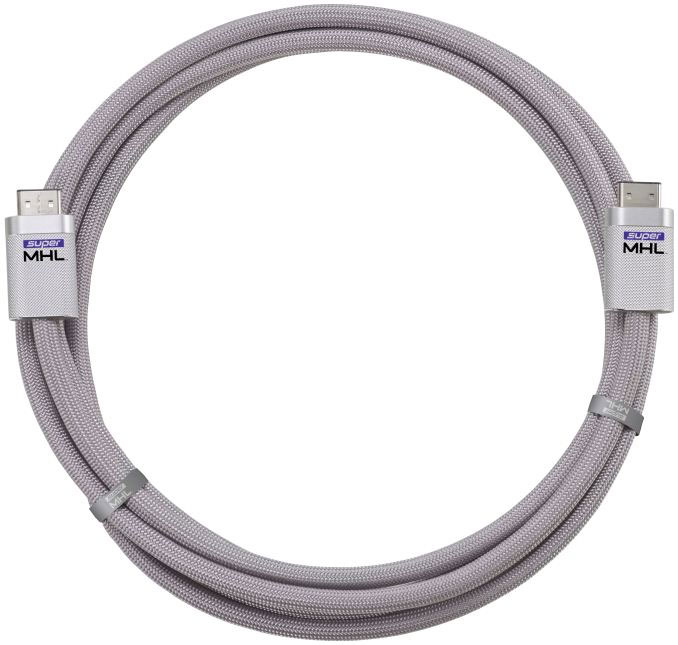The MHL Consortium has developed a new specification and cable solution to meet an unmet need – the desire to deliver 8K content over a single cable. At CES 2015 the Consortium revealed some details of the specification and a working prototype.
The MHL Consortium was organized to serve the mobile device market by using HDMI connectors to add additional functionality such as power delivery. MHL 2.0 allowed mobile devices to be connected to TVs using the micro USB to HDMI cable to deliver 1080p/60 content to the TV, while simultaneously recharging the mobile device. The latest specification, MHL 3.0, adds support for multiple displays, 10W of charge power and more. MHL 3.0 can allow 4K/30 content to be sent from a mobile device to a 4K display.
The MHL specification claims to be connector agnostic as long as you have 5 pins to support ground, power, charging and data (a twisted pair).
But the big news from CES was SuperMHL. This is a new specification that can now allow the delivery of 8K content at 120 fps in 36-bit color with 4:2:0 color sub-sampling – all over one cable. Alternatively, one can support Deep Color content as well with 48-bits of sampling.
To get there, SuperMHL uses six data lanes (twisted pairs) with each one running at 6 Mbps for a total of 36 Mbps. But that is still not enough bandwidth for the above type of content, so some light compression is added (using VESA DSC – Man. Ed.). There is also support for the BT 2020 color gamut and high dynamic range once the specification is set. Audio formats like Atmos, DTS-UHD and 3D audio are supported and there is an audio-only capability as well.
While the SuperMHL spec remains connector agnostic, the Consortium needed to develop its first dedicated cable to showcase the capability. The result is a 6 foot cable about three quarters of an inch in diameter with heavy shielding on the outside. This is a 32-pin connector on either end that is completely reversible. The final specification is due by the end of January, but it is backward compatible with other specifications (not identified) and can now support charging devices that need up to 40W of power. No distance specification was given, but it is not likely to extend much beyond 6-8 feet or so.
To demonstrate the capabilities of SuperMHL, the Consortium teamed up with member Samsung. Samsung brought a newly developed 8K display to the MHL booth in the South Hall (one of only two at the event). This is a 120” display that is still a prototype.

8K content was stored on a proprietary hard drive and fed to the One Connect box that is used in Samsung’s higher end TVs. This box was modified to add the SuperMHL connector and functionality with signal delivered over the SuperMHL cable to the 8K TV. As expected, the image quality was exceptional.
SuperMHL can also support multiple displays, which means that consumers can link their mobile devices, set-top boxes (STBs), Blu-ray Disc players, AVRs, streaming media sticks and other source devices to TVs and displays with full access and control of each compatible device. Naturally, there is also HDCP 2.2 and HEVC support as well.
While the SuperMHL-to-SuperMHL connector was shown at CES, the spec will support cables that are Micro-USB-to-SuperMHL and USB Type C-to-SuperMHL as well. However, a micro USB connection will only support 1 data lane but the Type C connector can support 2 or 4 of the 6 data lanes specified in SuperMHL.
There are 5 major founders of MHL (Samsung, Sony, Silicon Image, Nokia and Toshiba) and they expect to finalize the SuperMHL spec soon for adopters. There are over 200 adopter companies in MHL already. The SuperMHL specification will be available for download at the end of January 2015 at: http://www.mhltech.org
Check our video
Display Daily Comment
MHL’s connector agnosticism is a “two-edged sword”. On the one hand, it allowed Samsung to implement the technology on some of its Galaxy phones, using a standard Micro-usb. On the other hand, the lack of standardisation means that it’s hard to make peripherals that are universal.
You can expect that the MHL consortium will introduce a USB Type-C alternate mode for SuperMHL and also that DisplayPort will react. (BR)



